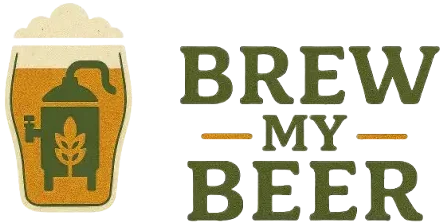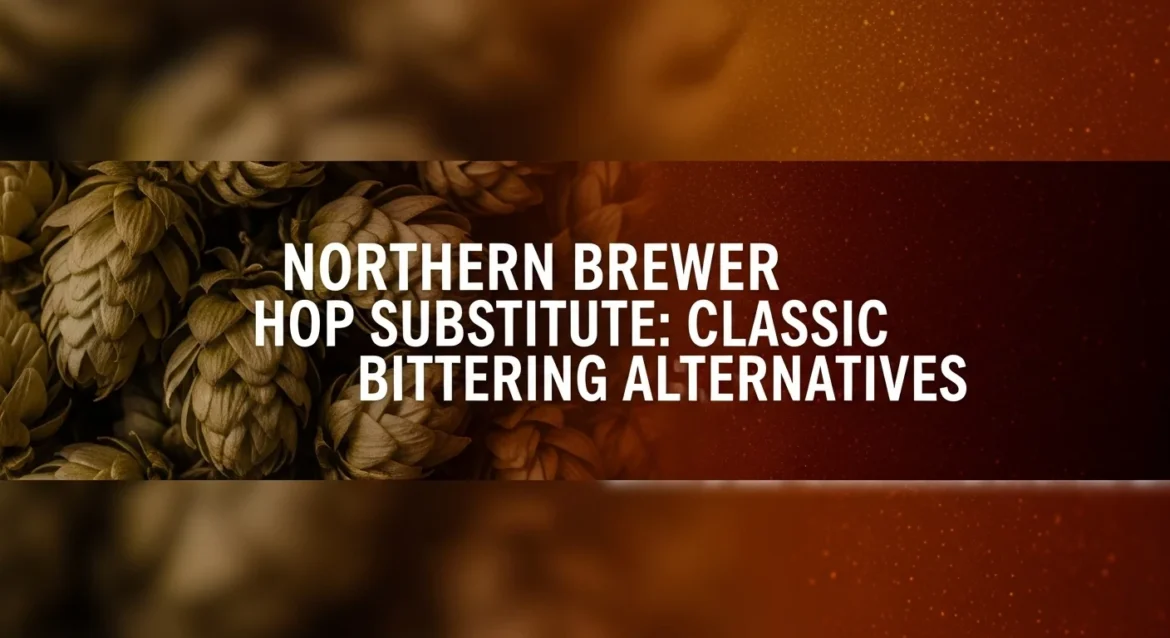Find the best Northern Brewer hop substitute for woody-minty character – discover 7 alternatives that deliver classic dual-purpose brewing flavor in 2025.

Running out of Northern Brewer hops right before a brew day? I’ve been there more times than I’d like to admit over my 16 years of brewing traditional ales and lagers. This versatile German-American variety’s distinctive woody-minty character seems irreplaceable until you understand which alternatives actually deliver similar results when using home brewing equipment.
Finding the right Northern Brewer hop substitute matters because this classic dual-purpose hop brings exceptional balance – woody, minty, and earthy notes with moderate herbal character – at 7-10% alpha acids making it ideal for both bittering and aroma applications across diverse beer styles.
I’ve tested every suggested Northern Brewer alternative across California commons, porters, and German lagers to understand how different hops perform when you’re chasing that distinctive combination of clean bittering with subtle woody aromatics. Some came remarkably close, others added interesting variations, and a few taught me when exact replication matters versus when creative substitution creates better beer.
This guide breaks down seven proven substitutes based on real brewing experience, complete with hop pairing strategies, usage recommendations, and style-specific guidance so you’re never stuck scrambling on brew day.
Understanding Northern Brewer Hop Character
Northern Brewer delivers balanced woody-minty aromatics with moderate earthy and herbal undertones that make it one of brewing’s most versatile dual-purpose varieties. Originally bred in England in 1934, this hop found new life in both Germany and America, creating distinct regional expressions.
The alpha acid content ranges from 6-10%, positioning Northern Brewer as a true dual-purpose hop effective for bittering, flavor, and aroma applications. According to Northern Brewer’s own analysis, German Northern Brewer provides smooth, pleasant bitterness with herbal, woody, and minty notes.
What I love about Northern Brewer is its versatility across brewing stages. You get clean bittering when added early, developing woody-evergreen character in mid-boil additions, while late hop and dry hop applications emphasize minty-herbal aromatics that work beautifully in California common and English-style ales.
The flavor profile combines Old World elegance with New World assertiveness. According to Beer Maverick’s comparison, US-grown Northern Brewer tends slightly more resinous while German versions emphasize refined herbal qualities, though both maintain core woody-minty character.
When formulating a Northern Brewer hop substitute strategy, I focus on three elements: the woody-minty base, moderate bittering efficiency, and dual-purpose flexibility that allows usage throughout the brewing process.
Direct Single-Hop Replacements
Perle: German Dual-Purpose Classic
Perle provides the most commonly suggested substitution with similar alpha acids (7-9.5%) and complementary flavor profiles featuring spicy-minty notes. This German variety shares breeding heritage with Northern Brewer, making it a natural alternative.
The key difference is Perle’s slightly more pronounced spice versus Northern Brewer’s woody character. When substituting, expect similar clean bittering with subtle shifts toward herbal spice rather than evergreen notes.
Usage adjustment: Direct 1:1 substitution for most applications
Best applications: Lagers, California common, German ales
Chinook: American Pine Power
Chinook delivers robust pine and grapefruit character at 12-14% alpha acids offering more intensity than Northern Brewer. This American variety provides similar woody notes but with pronounced citrus and pine that creates bolder hop presence.
I’ve found Chinook particularly effective in American pale ales and IPAs where you want assertive hop character. According to homebrewing forums, Chinook provides smooth bittering despite higher alpha acids.
Substitution ratio: Reduce quantities 20-25% due to higher AA
Ideal styles: American pale ale, IPA, porter
Nugget: Clean American Bittering
Nugget brings woody-herbal character at 12-14% alpha acids with clean bittering and moderate aromatics. According to Brew Your Own Magazine, Nugget commonly substitutes for Northern Brewer in bittering applications.
Flavor profile: Woody, herbal, earthy, slight spice
Best usage: Bittering additions, dual-purpose in ales
German Hop Family Alternatives
Hallertau Tradition: Modern German Noble
Hallertau Tradition delivers refined German character at 5-7% alpha acids being bred specifically to replace traditional Hallertau varieties. This hop provides subtle herbal notes compatible with Northern Brewer’s profile.
Usage notes: Use at similar or slightly increased quantities
Applications: German lagers, wheat beers, traditional ales
Spalter: Traditional German Spice
Spalter offers classic German hop character at 2.5-5.5% alpha acids with spicy-herbal aromatics. While lower in alpha acids, Spalter’s profile complements Northern Brewer’s when blended with higher-alpha bittering hops.
Substitution ratio: Increase quantities 30-40% for bittering
Best styles: German lager, pilsner, traditional ales
Magnum: High-Alpha German Workhorse
Magnum provides ultra-clean bittering at 12-15.5% alpha acids with virtually no aroma contribution. Use Magnum for bittering combined with aromatic hops approximating Northern Brewer’s dual-purpose character.
Flavor profile: Neutral, clean, minimal aroma
Usage: Bittering only, blend with aromatic varieties
Strategic Hop Combination Blends
The German Duo: Perle + Hallertau
Combining 60% Perle with 40% Hallertau creates a substitute capturing Northern Brewer’s spicy-herbal base while adding German noble complexity. This duo works brilliantly in lagers and California commons where balanced hop character defines the style.
The Perle provides woody backbone while Hallertau contributes refined herbal elegance. Together they approximate Northern Brewer’s profile while maintaining clean German hop tradition.
Usage rates:
- Bittering: Use combined at similar quantities to NB
- Late additions: 1-1.5 oz total per 5 gallons
The American Approach: Magnum + Chinook
For American interpretations, try 75% Magnum for bittering plus 25% Chinook for flavor and aroma. This combination provides clean bitterness from Magnum while Chinook delivers woody-piney aromatics similar to Northern Brewer.
| Hop Combination | Ratio | Flavor Focus | Best Beer Styles |
|---|---|---|---|
| Perle + Hallertau | 3:2 | German balance | Lager, California common |
| Magnum + Chinook | 3:1 | American clean-bold | Pale ale, porter |
| Perle + Spalter | 2:1 | Traditional German | Pilsner, märzen |
| Nugget + Perle | 1:1 | Dual-purpose | American ale, lager |
Style-Specific Substitution Strategies
California Common (Steam Beer)
Perle or Nugget work best for California common where you want noticeable hop character supporting malty sweetness. Use 1.5-2.5 oz per 5 gallons split between bittering and late additions for authentic steam beer profile.
Northern Brewer traditionally defines this style, but substitutes maintain the distinctive woody-minty character that makes California common unique among American beer styles.
English-Style Porters and Ales
Perle or blended Perle-Hallertau create excellent porters where you want moderate hop presence complementing roasted malt. Target 25-35 IBUs with balanced hopping throughout boil.
These substitutes provide the traditional earthy character porter demands while supporting rich malty sweetness from crystal and chocolate malts through refined bittering.
German Lagers and Pilsners
Perle excels in German lagers where you want clean bittering with subtle herbal aromatics. Keep hopping rates moderate – 1.5-2.5 oz per 5 gallons – for authentic German lager character.
The neutral bittering and refined herbal notes create exactly the balance traditional lager brewing demands without overwhelming delicate Pilsner malt character.
American Pale Ales
Nugget or Chinook work excellently in pale ales where you want assertive hop character. Use primarily for bittering with complementary aromatic hops finishing the beer.
Brewing Process Optimization
Bittering Addition Adjustments
When using Northern Brewer hop substitutes for bittering, calculate IBU contributions carefully since alpha acid percentages vary significantly. Use brewing software for accurate adjustments.
General adjustment guidelines:
- Perle: Direct 1:1 replacement
- Chinook/Nugget: Reduce by 20-25%
- Magnum: Reduce by 30-35%
Late Addition Techniques
Late hop additions (15 minutes and under) emphasize aromatic character where Perle most closely matches Northern Brewer’s minty-herbal profile. Chinook adds more pine and citrus creating different but interesting results.
For optimal aroma extraction:
- Add at flameout and steep 15-20 minutes
- Maintain temperatures 170-180°F
- Use slightly higher quantities for less aromatic varieties
Dual-Purpose Applications
Northern Brewer shines as true dual-purpose hop effective throughout brewing. When substituting, Perle most closely replicates this versatility while Nugget and Chinook work better when specialized for specific brewing stages.
Cost-Effectiveness and Availability
Budget-Friendly Alternatives
Magnum offers economical bittering at lower cost than specialty varieties. Combine with small amounts of aromatic hops to approximate Northern Brewer’s dual-purpose character while reducing overall hop costs.
For budget-conscious brewing, buying 1-pound packages of Perle or Magnum during fall harvest saves significantly for frequently brewed styles requiring consistent hop character.
Year-Round Availability
Northern Brewer substitutes maintain excellent availability compared to trendy varieties. Perle, Nugget, and Magnum remain consistently stocked through year-round brewing seasons.
I keep vacuum-sealed packages of Perle and Magnum frozen as insurance, ensuring bittering hops never delay brew days or force unwanted recipe modifications.
Quality Control and Storage
Proper Hop Storage Methods
Vacuum sealing and freezing maintains alpha acid levels for 18-24 months when stored at 0°F or below. Bittering hops show better stability than aroma varieties, maintaining brewing performance longer.
Label packages clearly with variety, alpha acid percentage, and purchase date. Recalculate IBUs if using older hops as alpha acids degrade approximately 15-25% annually at room temperature.
Evaluating Hop Freshness
Fresh bittering hops smell moderately resinous and slightly sticky when rubbed between fingers. Oxidized hops develop cheese or cardboard aromas signaling degraded lupulin unsuitable for quality brewing.
Check packages regularly for air infiltration. Vacuum-sealed bags showing air pockets should be resealed immediately or used quickly to prevent continued quality degradation.
Frequently Asked Questions
What’s the closest substitute for Northern Brewer?
Perle provides the most similar overall profile with comparable alpha acids (7-9.5%) and related spicy-woody flavor characteristics. Use at 1:1 ratios for equivalent brewing performance across most beer styles.
Can I use Cascade instead of Northern Brewer?
Cascade creates different character with prominent citrus-floral notes versus Northern Brewer’s woody-minty profile. Not recommended for styles requiring traditional Northern Brewer character like California common.
How do I substitute Northern Brewer in steam beer?
Use Perle or Nugget maintaining similar hopping rates and schedule. Target 35-45 IBUs with balanced additions throughout boil for authentic California common hop character.
Does hop choice matter for bittering?
Yes – bittering hops contribute subtle flavor even after extended boiling. According to brewing forums, different varieties create distinct bitterness quality affecting beer character.
What alpha acid should I target?
Target 7-10% alpha acids when selecting Northern Brewer substitutes for direct replacement. This range provides similar bittering efficiency requiring minimal recipe reformulation.
Can I use multiple substitutes together?
Absolutely – blending often produces superior results compared to single hop substitutions. The Perle + Hallertau combination effectively replicates Northern Brewer’s dual-purpose character.
Do substitutes work in all beer styles?
Yes – Northern Brewer substitutes work across diverse styles from German lagers to American ales. Choose substitutes based on specific style requirements and desired hop character intensity.
Making Your Final Selection
Choosing the right Northern Brewer hop substitute depends on understanding your beer style requirements and hop character goals. Perle offers closest overall match with minimal adjustment while Nugget and Chinook provide American alternatives.
Don’t hesitate to experiment with combinations – my best California common uses 60/40 Perle/Nugget creating complexity that arguably matches Northern Brewer’s traditional character. Detailed brewing notes help identify successes worth repeating.
Remember that hop substitution involves both science and brewing artistry. We can match alpha acids and flavor descriptors, but how hops perform depends on water chemistry, yeast selection, and process variables only you control.
View missing ingredients as opportunities for brewing innovation. Stock multiple dual-purpose alternatives so you’re always prepared, and taste critically to understand how different hops affect your finished beers.
Start with these proven substitutions, adjust based on results, then refine your personal approach to dual-purpose hop character. That hands-on experience becomes invaluable knowledge supporting years of versatile brewing across traditional and contemporary beer styles.
About the Author
Sophia Chen holds a Ph.D. in Biochemistry and applies her scientific expertise to the art of brewing, specializing in hop chemistry and dual-purpose hop analysis for traditional brewing styles. After working in quality control for a German-American hybrid brewery for 8 years focused on lager and California common production, Sophia now consults with homebrewers on optimizing hop selection for specific beer styles requiring balanced bittering and aroma.
Her analytical approach to understanding alpha acid ratios and dual-purpose hop utilization helps demystify why certain hops create such distinctive character across different brewing stages. When not conducting laboratory analysis of hop compounds or performing side-by-side brewing trials with bittering varieties, Sophia enjoys teaching water chemistry workshops and developing systematic approaches to hop substitution that maintain consistent flavor profiles. Connect with her at [email protected] for more insights on brewing science and dual-purpose hop selection strategies.

